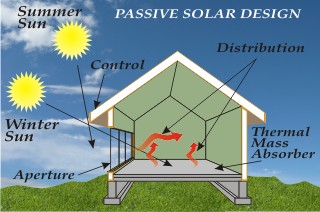Passive Solar Design

Most of us have heard of the term passive solar design. Some of us may associate the idea with unconventional, fully self-sufficient, ‘off the grid’ homes, but in fact mainstream builders, architects and homeowners are increasingly embracing the concept. Passive solar design is all about taking advantage of the suns free energy to improve the light and ambient temperature in the home. Elements of good passive solar design are properly sized and positioned windows, the correct choice of glazing, comprehensive insulation and ventilation.
A house design may incorporate some elements of passive solar design or it may go the whole way and bend every consideration to tapping the suns energy. The choice is yours. But most importantly, a passive solar designed house can be low-tech and no more expensive than standard construction. Free solar heat is an age-old benefit, and a house that correctly incorporates its principles will provide year-round comfort and enjoyment.
The first 30 minutes
The biggest design decisions are often made in the first 30 minutes of the first design meeting. Picture the scene – the client, architect or project manager consider the building brief. Then BANG, a flurry of sketches and activity and before you know it you have the beautiful outline of a building, car parks, decks and lovely mature trees… ‘That’s it’ says the client, Can it be done within the budget?’ This stimulates a further flurry of meetings and calculations. The building is developing at a lightning pace along a trajectory from which it is difficult to return. Everyone is doing their job and everyone is happy… but had energy efficiency and solar design been considered at first principles, the outcome may have been very different. Passive solar design not only affects the comfort and feel of a building, but greatly affects the running costs throughout the life of the building. Choosing a representative who incorporates these principles as standard practice will not only ensure a more comfortable home but will potentially save you considerably over the life of the investment.
Southern Orientation
In the Northern hemisphere, the sun travels in a southerly arc from east to west. Ideally, the south side of the house should have the most windows and the biggest windows. Sun will enter the living spaces for much of the day providing light, warmth and comfort. The east and west walls should also have windows, to catch morning and afternoon sun. The north side would ideally minimise the number and size of windows as generally speaking it is the cold side of the house.
Layout of rooms
Ideally, the rooms on the south side of the building should be the most used (eg living areas). The least used rooms (bathrooms, laundry, garage, and utility rooms) should go on the north side. Bedrooms and the kitchen are traditionally placed on the east side (because they need early morning heating, and in the case of the kitchen, afternoon coolness). Assessing other properties you may have stayed in will almost certainly identify those properties that you have felt the most comfortable as being close to this layout.
When you have a big blank canvas, that is, a large, flat plot of land, passive solar design is not especially difficult or costly to accomplish. On compact sites with close neighbouring properties however, compromises and a more complex arrangement of spaces will be necessary. Nonetheless, it is worth the effort because your building will be warmer, lighter and altogether more pleasant to live in. And your power bills will be lower!
Basic Principles of Passive Solar Design
There are three main factors that are most important to gaining benefit from the free energy from the sun. These are:
GLAZE
Use glazing to bring heat from the sun into the house – though glass must be selected, placed and sized carefully as even double glazing is a poor insulator when compared to a fully insulated wall.
INSULATE
Use insulation to slow the flow of heat in to and out of the house – heat from the sun is used more effectively in houses that are well-insulated. Insulation helps to maintain more constant internal temperatures and reduces the need for heating in winter and cooling in summer. On a performance per dollar basis, insulation is easily the most cost effective way to improve the energy efficient performance of your home.
ADD THERMAL MASS
Where possible using heavyweight materials (thermal mass) to soak up heat from the sun and release it slowly into the house when temperatures drop will maintain more comfortable temperatures – it will overheat less often and not cool down so quickly overnight.
Other important factors to consider in your homes passive solar ecosystem are:
STOP AIR LEAKAGE
Once a house is well-insulated and appropriately glazed, the biggest potential heat loss is through draughts around windows, doors and other construction joints. Fortunately building techniques in Hokkaido have this area pretty well covered however and houses tend to be relatively airtight.
VENTILATE
An air-tight house however requires active ventilation to maintain fresh air quality, to reduce condensation, and to remove cooking and other odours. Appropriate placement of windows for good cross flow of air through rooms will make them more effective for cooling on hot days.
SHADE
External shading may also be used to manage the heat gain from the sun in summer and to prevent overheating. Well-designed window systems must not only collect heat from the sun in the winter, but also exclude it in the summer when it might cause overheating.
The science of passive solar design requires a specialist to consider the specifics of your individual site and to incorporate passive solar design principles into the layout and design of your home. Niseko Projects embraces elements of passive solar design philosophy into all our projects with the belief that
We are a part of our environment, not apart from it
With the reduced load on local energy supplies from a house utilising passive solar design principles you can also sleep well in the knowledge that you can Save on your bills while at the same time saving the planet!
